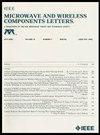208–233 GHz倍频器,在28 nm CMOS中具有1.1%的功率添加效率
IF 3.3
2区 工程技术
Q2 ENGINEERING, ELECTRICAL & ELECTRONIC
引用次数: 1
摘要
这封信介绍了台积电28纳米CMOS技术中的完全集成倍频器。在差分驱动放大器中引入MOS晶体管电容器中和,在PVT变化下表现出比MOM电容器中和更好的鲁棒性。此外,设计了一种基于堆叠变压器的巴伦,以实现良好的平衡性能。还讨论了虚设金属对所提出的巴伦性能的影响。测量结果表明,3dB带宽为25 GHz(208–233 GHz),峰值功率增加效率为1.1%,222 GHz下的直流功耗为26.4 mW。峰值转换增益为−7.2 dB,在−7至1-dBm输入功率范围内,转换增益的变化小于1 dB。此外,芯片尺寸为$492×412\,\,\mu\text{m}^{2}$,包括GSG和DC焊盘。本文章由计算机程序翻译,如有差异,请以英文原文为准。
A 208–233-GHz Frequency Doubler With 1.1% Power-Added Efficiency in 28-nm CMOS
This letter presents a fully integrated frequency doubler in the TSMC 28-nm CMOS technology. MOS transistor capacitor neutralization is introduced in the differential driving amplifier, which shows better robustness than MOM capacitor neutralization under PVT variations. Besides, a stacked transformer-based balun is designed to achieve good balance performance. The effect of dummy metal on the performance of the proposed balun is also discussed. The measured results show that the 3-dB bandwidth is 25 GHz (208–233 GHz) and the peak power-added efficiency is 1.1% with a dc power consumption of 26.4 mW at 222 GHz. The peak conversion gain is −7.2 dB and the variation in conversion gain is less than 1 dB within −7- to 1-dBm input power range. Moreover, the chip size is $492\times 412\,\,\mu \text{m}^{2}$ , including GSG and DC pads.
求助全文
通过发布文献求助,成功后即可免费获取论文全文。
去求助
来源期刊

IEEE Microwave and Wireless Components Letters
工程技术-工程:电子与电气
自引率
13.30%
发文量
376
审稿时长
3.0 months
期刊介绍:
The IEEE Microwave and Wireless Components Letters (MWCL) publishes four-page papers (3 pages of text + up to 1 page of references) that focus on microwave theory, techniques and applications as they relate to components, devices, circuits, biological effects, and systems involving the generation, modulation, demodulation, control, transmission, and detection of microwave signals. This includes scientific, technical, medical and industrial activities. Microwave theory and techniques relates to electromagnetic waves in the frequency range of a few MHz and a THz; other spectral regions and wave types are included within the scope of the MWCL whenever basic microwave theory and techniques can yield useful results. Generally, this occurs in the theory of wave propagation in structures with dimensions comparable to a wavelength, and in the related techniques for analysis and design.
 求助内容:
求助内容: 应助结果提醒方式:
应助结果提醒方式:


